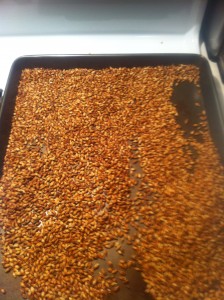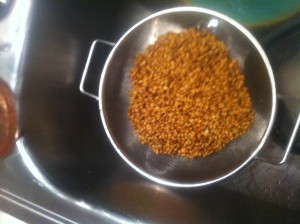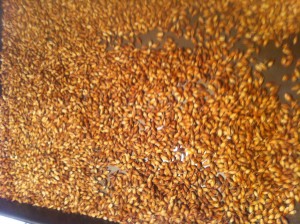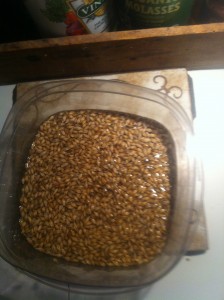 I recently bought 10 pounds of 2-row from Valley Malt, with the idea of using it as part of an American Pale Ale SMaSH (Single Malt and Single Hop) brew with some extra Summit hops I have sitting around. The name of this fine beverage: Pale Ale #2, of course.
I recently bought 10 pounds of 2-row from Valley Malt, with the idea of using it as part of an American Pale Ale SMaSH (Single Malt and Single Hop) brew with some extra Summit hops I have sitting around. The name of this fine beverage: Pale Ale #2, of course.
After some thought, I decided the recipe needs some color and a touch of residual sweetness, so I thought I’d take a shot at toasting some of the 2-row myself, aiming to make a 40-60L crystal malt. Whether or not this should still be considered a SMaSH is open to debate.
First, some background on crystal malt (a.k.a. caramel malt):
Crystal malts are wetted and roasted before kilning. They produce strongly sweet toffee-like flavors. Crystal malts are available in a range of colors, with darker-colored crystal malts (those kilned at higher temperatures) producing stronger, more caramel-like overtones. Some of the sugars in crystal malts caramelize during kilning and become unfermentable; hence, addition of crystal malt will increase the final sweetness of a beer. They contain no enzymes. (Wikipedia)
I followed the guidelines in Randy Mosher’s Radical Brewing.
- First, I soaked the grain in dechlorinated tap water for 24 hours. It developed a little bit of foam and a familiar aroma: is there a very slight mash going on here?
- Next, I drained the grain well, and poured it into a pie plate so it sits about 2″ deep.
- Then, with my crappy oven set as low as it could go (about 180 degrees), I roasted it for 2 hours, until it was mostly dry. Around this time, I forgot that I was supposed to be taking pictures.

- Next, I dumped the grain out onto a cookie sheet, and then raised the temperature to 200 degrees. This quickly finished drying the malt, and filled the house with a really nice nutty-bready aroma.
- Finally, I raised the temperature to 300 degrees. The grain quickly started to toast. After about 90 minutes (stirring every 15 minutes or so) the color was somewhere between a 40L and a 60L. The smell was intense, very nutty and slightly burned. The grain tasted more like a brown malt than a typical crystal (probably because of incomplete conversion during the initial low temperature “mash” step) but does have a nice residual sweetness.
 I plan to age this for two weeks or so, to let the aroma mellow a bit (commercial toasted malts are often aged for months before being sold). I think it’ll add a nice sweet, nutty touch to Pale Ale #2.
I plan to age this for two weeks or so, to let the aroma mellow a bit (commercial toasted malts are often aged for months before being sold). I think it’ll add a nice sweet, nutty touch to Pale Ale #2.

